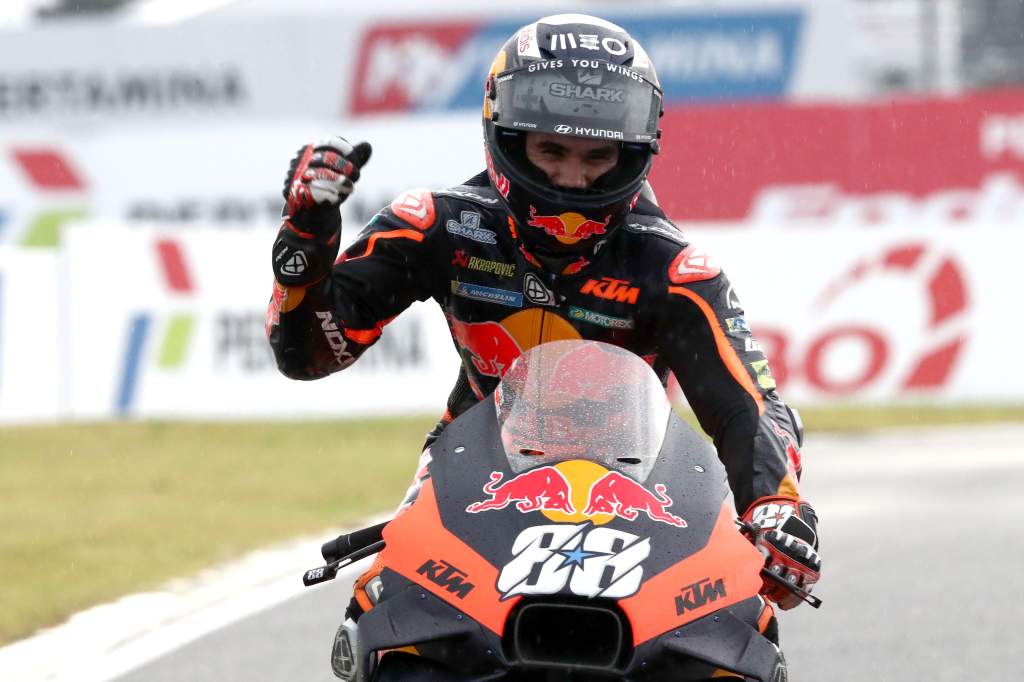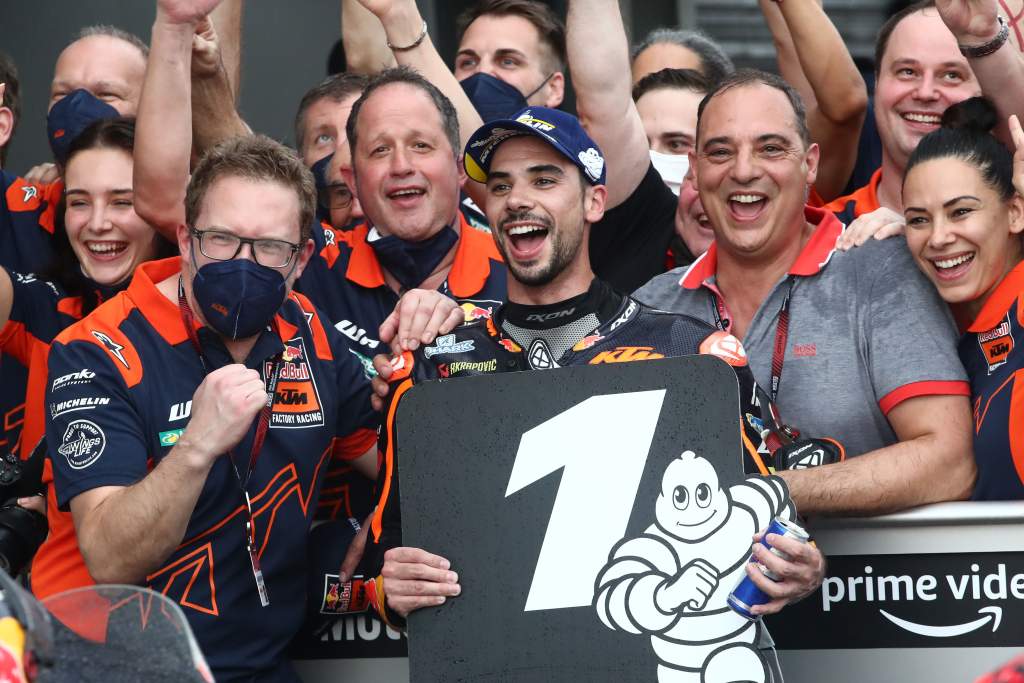Among MotoGP’s hallowed ‘class of 2019’, it is easy to see Miguel Oliveira as something of an outlier next to Joan Mir, Fabio Quartararo and Francesco Bagnaia. The Portuguese himself clearly doesn’t shy away from that.
“I’ve entered [MotoGP] in an era of Mir, Pecco and Fabio and they’ve already fought for big things,” he told MotoGP.com earlier this month. “I feel myself with the same riding skills as they, but I didn’t have really the moment to be there yet – but it will arrive. And so I believe my role in MotoGP, it’s still a lot to be written, and I see myself as a world champion, it’s something that I think will be a matter of time.
“Not to sound arrogant or anything, but I believe I have the skills, I believe I can do it, so it’s a matter of just putting the work and grabbing the opportunity.”
In certain ways, he’s already up there within that 2019 group, especially after Mandalika. He has four wins – fewer than Quartararo, but same as Bagnaia and (considerably) more than Mir. And the share of those wins within the bike manufacturer he represents is most impressive – Oliveira’s responsible for four of six KTM victories since 2019 (and also, well, ever), compared to eight of 15 for Quartararo at Yamaha, four of 13 for Bagnaia at Ducati and one of four for Mir at Suzuki in that same time period.
And yet, Mir and Quartararo are already MotoGP champions, and Bagnaia finished second last year, whereas Oliveira’s three full seasons read as follows – 17th, ninth, 14th. Framed like that, it’s easy to see why there is no real doubt that the other three will (or already have) secure long-term stays within MotoGP factory teams, whereas Oliveira entered the season with his KTM ride shrouded in a cloud of uncertainty beyond 2022.
The Mandalika win will have dispersed that cloud somewhat, albeit the fact that KTM protege Raul Fernandez isn’t yet having the instant impact in MotoGP at Tech3 as he’d had in Moto2 is potentially a bigger factor.
Yet his walkover in Indonesia is also a strong reminder why it’s not just KTM that should be eyeing Oliveira, who really should be a top consideration on the rider market for whichever teams are left empty-handed once Quartararo and Mir have made up their minds for the future.
As it stands, Oliveira is the current MotoGP crop’s ultimate feast-or-famine rider. There’s a whole bunch of stats you can pluck out to support that – and indeed I’ve done just that – but it’s also an argument that passes the eye test.
Active MotoGP race winners by points per race
Marc Marquez – 16.98
Fabio Quartararo – 11.77
Andrea Dovizioso – 10.89
Maverick Vinales – 9.63
Joan Mir – 9.63
Alex Rins – 8.43
Brad Binder – 7.82
Francesco Bagnaia – 7.22
Jorge Martin – 6.94
Enea Bastianini – 6.60
Jack Miller – 6.20
Franco Morbidelli – 6.0
Miguel Oliveira – 5.54
Share of total points accrued in just wins
Marc Marquez – 60.75%
Miguel Oliveira – 36.10%
Fabio Quartararo – 32.05%
Francesco Bagnaia – 28.25%
Jorge Martin – 22.52%
Franco Morbidelli – 19.53%
Maverick Vinales – 19.15%
Enea Bastianini – 18.94%
Brad Binder – 18.80%
Andrea Dovizioso – 14.59%
Alex Rins – 10.85%
Jack Miller – 10.16%
Joan Mir – 5.09%
Of Oliveira’s four wins, the maiden one at the Red Bull Ring is the only one that can be seen as looking at all lucky – Jack Miller and Pol Espargaro both ran out wide in the final corner, and he was there to pick up the pieces.
In the other ones, though, he flat out battered the field. He led every lap at Portimao, 21 of 24 at Barcelona and 17 of 20 at Mandalika. Of those, only Barcelona really looked in any doubt given pressure from Quartararo before his leathers opened up, and a subsequent charge from Johann Zarco – but he did genuinely seem to have both covered.
And while Mandalika was wet, the superb grip provided by the venue in those conditions seemingly made it a much more conventional race than rain grands prix tend to be, with not much in the way of shocks in the classification aside from Oliveira’s commanding triumph.

The thing is, that win came immediately after a stretch of 10 races that yielded a hideous seven points. Part of that was undoubtedly the wrist injury he sustained at the Red Bull Ring – an injury Oliveira himself admits he “could’ve dealt with better, maybe to have stopped immediately after the crash would’ve been smarter, but it’s something we can only say with time”. Yet it was clearly not just down to the physical limitation throughout – and even at the start of 2022, before Mandalika, he hasn’t quite looked a reliable match for team-mate Brad Binder.
Yet most riders simply cannot run a MotoGP race the way Oliveira has now proven he can on three separate occasions. You don’t run away with three premier-class races in three high-pressure situations if you’re not a potential superstar.
Oliveira is 27, and has never been champion in Moto3 and Moto2, but he has already flashed his full potential to the whole premier-class paddock, and it’s hard to believe that there won’t be suitors who believe they can coax that form out of him on a more regular basis.
Only Ducati is really not much of a match at all, given the preponderance of proven race winners in its existing roster. But Yamaha or Suzuki could certainly do much worse if they find themselves needing to replace Quartararo or Mir respectively. Yamaha, after all, apparently already made an overture towards Oliveira last year.
Honda too surely must take a look, even outside of the context of Marc Marquez’s unfortunate lingering health issues. And then there’s Aprilia, which will sooner or later need to replace Aleix Espargaro, who doesn’t seem intent on sticking around beyond one more contract cycle.
Of course, the smart money has to be on Oliveira staying at KTM, now that it’s suddenly a much more competitive proposition and one under new leadership that has set a target to put more of an emphasis on rider morale. But in that regard, the next few races, in presumably more conventional circumstances, will be telling.

Oliveira can’t beat Binder to a seat, he can only remain alongside the already-2024-contracted South African. If KTM has its head turned by another option, it’s Oliveira’s seat to lose by default.
He himself has made it clear that, as happy as he’s been to be part of KTM for so long, it’ll be better to head elsewhere if “something is not clicking”.
But it clicked big-time in Indonesia. And it’s not just KTM that will have taken note.



